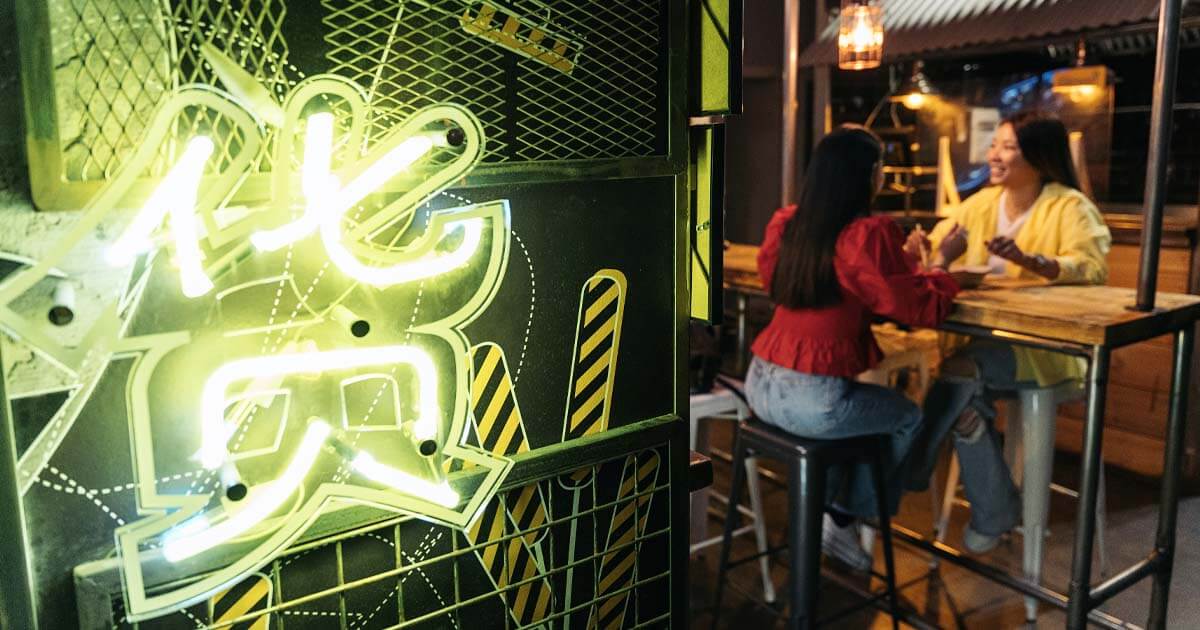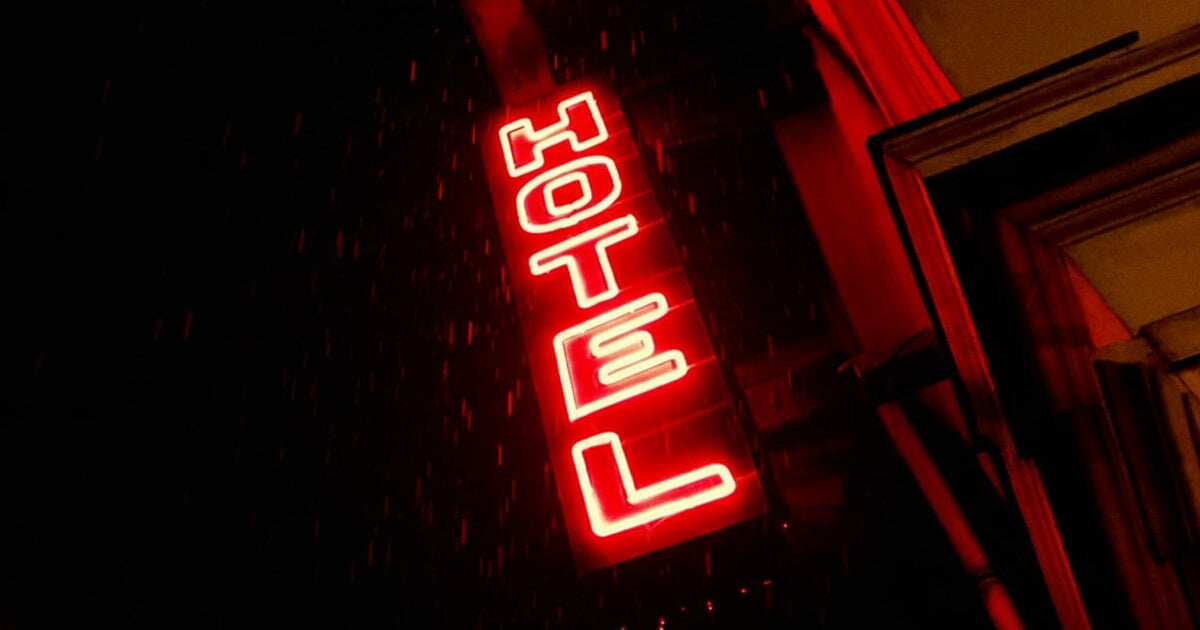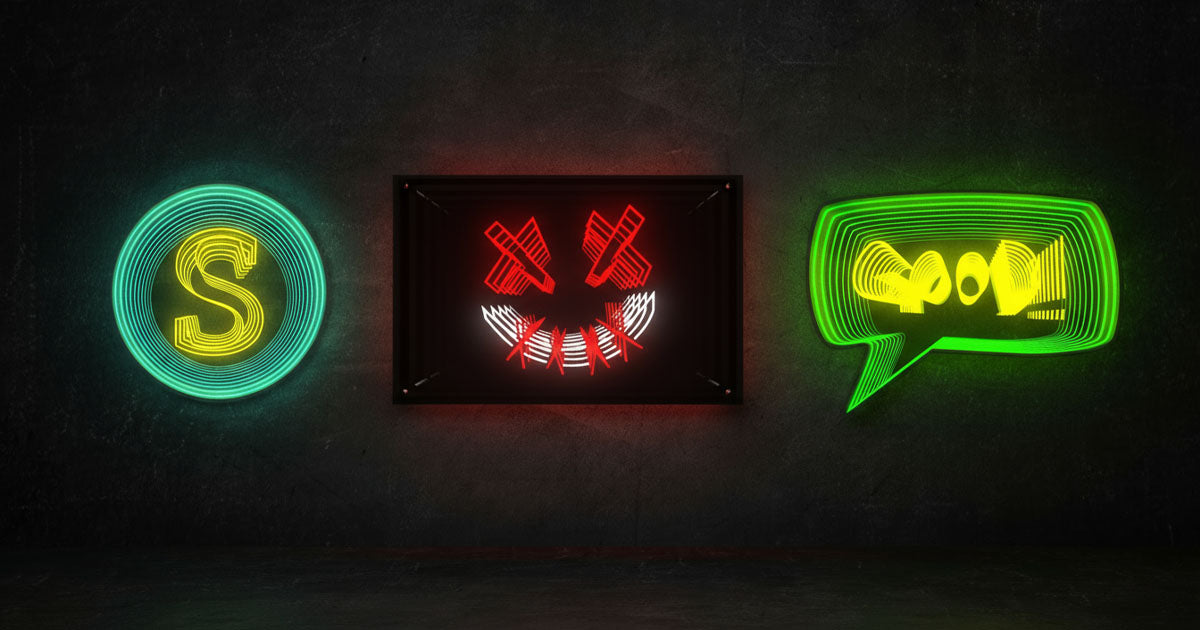 LED neon signs are a modern and energy-efficient alternative to traditional glass neon signs. Unlike glass-made neon signs, which are fragile and risky, LED neon signs are made from flexible LED strips wrapped in durable casings. This design greatly reduces breakage and eliminates hazardous exposure.
LED neon signs are a modern and energy-efficient alternative to traditional glass neon signs. Unlike glass-made neon signs, which are fragile and risky, LED neon signs are made from flexible LED strips wrapped in durable casings. This design greatly reduces breakage and eliminates hazardous exposure.
Safety is one of the most important things concerning these lights; thus, users should understand how to use them properly and follow the safety measures.
Following are some of the considerations:
-
Low Voltage Operation: LED neon signs operate at low voltage and are thus much safer to use than traditional neon signs.
-
Reduced Heat Production: They emit very low heat, whereas conventional neon does; hence, they are safe to touch.
-
No Hazardous Gases: LED neon signs are much safer, inside and outside, because they do not contain toxic metals like mercury.
Following these safety suggestions will make your neon LED sign long-lasting and the environment much safer.
Understanding LED Neon Signs Safety
The LED neon signs use flexible LED strips designed to have the same appeal as the traditional glass neon tubes. The new technology also adds several benefits, such as safety and energy efficiency.
 LED neon signs emit low heat and, therefore, are safer than the traditional neon lights. The low heat output of LED neon signs brings several benefits:
LED neon signs emit low heat and, therefore, are safer than the traditional neon lights. The low heat output of LED neon signs brings several benefits:
-
It reduces the risk of burns if someone accidentally touches the sign.
-
These signs are safer to place near other objects without worrying about heat damage or fire hazards.
-
You can install them on heat-resistant materials, like wooden surfaces or fabric backgrounds.
The low heat emission also extends the sign's life because high temperatures often cause lighting components to fail more quickly. This makes LED neon signs safer, more durable, and reliable for long-term use.
Key Safety Features of LED Neon Signs
1. No Harmful Gases
Unlike traditional neon signs, LED neon signs do not contain harmful gases like mercury. This considerably reduces the health problems concerning tube breakage, and they can be installed safely indoors and outdoors.
2. Low Voltage Operation
LED neon signs are low-voltage and generate low heat. Unlike conventional neon signs, they are safe to touch and do not threaten or risk burns.
Installation Considerations
The safety of installation is the most crucial factor. There are suggestions on electrical connection points that one should consider as precautionary measures against possible hazards. Here are some key points to ensure the installation is safe:
-
Check Voltage Compatibility: Ensure the power supply matches the voltage needs of your LED neon sign to avoid possible overheating or overloading of the circuit.
-
Avoid Overloading Circuits: Overloading results in electrical breakdown and heightens the potential for fire hazard incidents. If you install multiple signs, you must distribute the electrical load properly.
 The above safety features and installation safety measures will make your experience with LED neon signs enjoyable and safe.
The above safety features and installation safety measures will make your experience with LED neon signs enjoyable and safe.
This combination of energy efficiency, durability, and safety makes LED neon signs a superior option for lighting up your space.
LED Neon Sign Safety Checklist
Keeping your LED neon sign safe is both a matter of function and durability. Follow this LED neon sign safety checklist, as this will reduce risk when in use:
1. Verify Voltage Compatibility
Ensure your LED neon sign is compatible with your home's voltage supply. Proper voltage operation prevents overheating and reduces the risk of electrical hazards.
Most LED neon signs have low voltage: 12V to 24V DC, powered by a power adapter or transformer. This contrasts with the high voltage of traditional neon signs, which run on voltage levels of 1000V-15000V.
Always check with the manufacturer for the requirements for your power supply to match the voltage requirements of your LED neon sign and prevent overheating or circuit overloads.
2. Regular Inspections
Regularly check for wear and tear on the LED neon sign; check for:
-
Frayed wires
-
Cracked LED tubing
Checking regularly identifies any issue before it becomes a serious problem.
3. Maintain Safe Distances
LED neon signs must be kept away from flammable materials. They avoid all fire threats and safely work with all signs. Also, the sign should be installed so it doesn't fall accidentally, which may damage it.
Doing these will improve the safety of your LED neon sign and its aesthetic and performance value. By being proactive, you'll provide a far safer environment in which you can reap the beautification benefits of such modern lighting solutions.
Safety Guidelines for Using LED Neon Signs
Safety standards ensure that LED neon signs are handled and installed safely. This involves complying with the electrical standards when installing them.
Following these standards decreases the risk of improperly handling and installing them.
Key considerations include:
1. Installation Guidelines
-
Use appropriate connectors and cables that will fit the particular voltage requirements of the LED neon sign.
-
Ensure that the power supply meets the specifications of the neon sign to avoid overheating.
2. High-Quality Materials
-
Always check for a high-quality LED neon sign materials, like high-grade PVC or silicone, which provide excellent environmental protection and negligible wear and tear on the LED neon signs.
-
Avoid the cheap ones, which would affect your safety and durability.
3. Professional Installation (If Needed)
-
It is highly advised to use licensed installers with experience who can ensure that all the connections meet the safety codes and minimize risks.
-
Professionals can also find the best mounting locations that ensure stability and visibility.
4. Child and Pet Safety Considerations
-
Keep LED neon signs out of children's reach by installing them at a higher position.
-
Hide all power cords and cables to avoid children pulling on them.
-
Expose no wires; instead, use cord covers or clips in areas.
-
Prefer wall installations over free-standing signs to avoid tipping hazards.
-
Ensure the sign is installed securely so it won't fall if bumped or touched.
-
Select signs with rounded edges and corners to avoid injury in the event of accidental contact.
-
Place power supplies and transformers out of the reach of pets since they tend to get warm during operation.
-
Choose signs that have auto shut-off for extra safety measures.
-
Regularly inspect for loose parts or breakage that might cause injury to your child or pet.
-
If your neon LED sign has a remote, keep it out of your child's reach.
 These precautions will let one enjoy an LED neon sign's aesthetic beauty without compromising safety.
These precautions will let one enjoy an LED neon sign's aesthetic beauty without compromising safety.
Electrical Safety Considerations with LED Neon Signs
Electrical safety is crucial when working with LED neon signs. The danger of poor wiring and installations must be realized to avoid serious accidents.
Proper Electrical Connections
-
Use the proper power adapter that your neon sign manufacturer provides.
-
Make sure all the connections are properly insulated and protected from water.
-
Use Surge Protector: to protect your sign against voltage surges,
-
Do not cut or alter an original power cord or adapter.
-
Make sure all wire connections are tight and secure.
-
Do not overload the circuit by attaching multiple signs on a single power source.
-
Keep connections away from water sources and moist areas.
-
Regularly check power cables for cuts, abrasions, or fraying.
-
Never use frayed power cords or adapters.
-
Power connections should be labeled to avoid confusion.
-
All electrical connections should be within easy reach for maintenance.
Risks of Improper Wiring
-
Short Circuits: Poor wiring may cause short circuits that cause fires or damage the sign.
-
Overloading Circuits: Connecting multiple signs without considering the capacity of the circuit overload systems is a fire hazard.
-
Inconsistent Voltage: Operating on inconsistent voltage may burn up the sign and present an electric shock hazard.
Tips for Preventing Electric Shock
-
Use Ground Fault Circuit Interrupters (GFCIs): The devices monitor for ground faults and turn off power to reduce the risk of electric shock.
-
Regularly Inspect Connections: Check for frayed wires or loose connections. Get them repaired to maintain safety.
-
Avoid Moist Locations: Install the signs only in dry locations. Moisture enhances electrical risks.
-
Educate Users: Educate everyone at home or in the business place to use the sign safely and minimize many risks.
These will add safety to Neon Sign Use and have a stylish, vibrant display.
Fire Hazards and Prevention Measures with LED Neon Signs
Knowing the possible fire risks of LED neon signs is essential for safe usage. While the signs are much safer than conventional neon, there is still danger due to the following reasons:
-
Overheating: Incorrect installation of the sign or its connection to an inappropriate power supply may produce too much heat.
-
Poor Ventilation: Signs mounted in small spaces with inadequate ventilation can cause heat traps.
-
Flammable Materials: Mounting LED signs near flammable materials can catch fire in the event of excess heat.
A few such effective precautionary ways to minimize the hazards of fire include:
1. Professional Installation (Optional): Let the qualified technicians install your LED neon signs, observing all electric safety rules in which the sign will be well secured on-site to avoid falling and possible damage.
2. Regular Inspections: Check regularly for wear and tear, damaged cables, and loose connections. Fix any problems right away.
3. Appropriate Placement: Signs should be kept away from combustible materials or areas subjected to overheating. A few inches away from a wall or any object is recommended.
With proper care and following the above suggestions, you can enjoy the beauty of an LED neon sign without compromising environmental safety.
Health and Environmental Safety Aspects of LED Neon Signs
LED neon signs are much better for health and environmental safety than traditional neon signs.
Health Hazards Related to Traditional Neon Signs
Traditional neon signs contain several glass tubes containing gases like neon or argon. When they break, the glass tubes shatter into sharp shards, resulting in cuts and wounds. They may also contain mercury, which, if released, is dangerous from a health standpoint.
Safety with LED Neon Signs
On the other hand, LED neon signs are made with flexible LED strips covered in a protective material, such as PVC or silicone. This design minimizes the risk of breakage and prevents exposure to harmful chemicals.
Environmental Benefits of LED Neon Signs
Environmental benefits are also noteworthy:
-
Energy Efficiency: LED neon signs consume around 80% less power than traditional ones. Lower carbon footprints equate to lower power consumption.
-
Reduced Waste: LED signs are well-built and contribute to durability to reduce waste emanating from numerous replacements. In contrast to the old neon, which contributes to increased waste in landfills due to broken glass and toxic components, this LED signage is eco-friendly for the customer.
While the LED technology enhances safety, it also protects the environment.
Best Practices for Installing LED Neon Signs Safely
It is essential to safely install LED neon signs to enjoy their maximum benefits and minimize the risks. Follow this simple step-by-step safe installation guide:
 1. Select the Right Location: Choose a stable surface away from moisture and direct heat. Make sure the location is well-ventilated.
1. Select the Right Location: Choose a stable surface away from moisture and direct heat. Make sure the location is well-ventilated.
2. Check Voltage Compatibility: To prevent overheating or electrical problems, ensure your power supply is compatible with the voltage of the LED neon sign you will install.
3. Secure Mounting: Install the sign using proper mounting hardware and, if outdoors, with weather-resistant materials.
4. Don't Overload Any Circuit: Make sure the circuit you plug this into will not overload the capacity of that circuit once you add the neon sign to it.
5. Professional Assistance: If the installation is complicated or outdoors, hire an electrician (this could be optional).
6. Follow Manufacturer Guidelines: Follow any special installation instructions offered by the manufacturer to the letter to ensure functionality and safety.
Doing so lets you enjoy your LED neon signs, ensuring aesthetic value and safety.
Safety Installation Tips For Indoor and Outdoor Usage Setting
While the guides above focus on general safety measures, indoor and outdoor installation factors must also be considered.
-
Place the neon sign where it will be free from combustible materials and moisture for indoor installations, and position it higher, but make sure it is visible.
-
Outdoor installations need special considerations since they will be exposed to the elements. The installation should withstand wind, rain, and other environmental factors.
Consider using a protective cover or varnish to prevent UV damage and prolong the sign's life.
Have the sign periodically checked for wear and tear, such as flickering lights and exposed wire; these should be attended to immediately to avoid more serious consequences or hazards.
Safety always matters when fitting LED neon signs. By observing the tips above, one will be safe and reduce risks.
Maintenance and Inspection Protocols for LED Neon Signs
Good maintenance ensures the long life and safety of an LED neon sign. Periodically scheduled checks or inspections will avoid issues before they arise, maximize performance, and detect possible failures.
Recommended Maintenance Schedule
Monthly Inspections
-
Check physical damage: enclosure cracks or frayed wires.
-
Check that all connections are tight and free of corrosion.
Quarterly Cleaning
-
Dust the sign with a soft-bristled brush or feather duster to wipe out dust and dirt particles.
-
For further cleaning, use a wet cloth with mild soap, not strong chemicals, which would damage the surface.
Biannual Professional Assessment
-
Engage the services of a certified electrician to conduct an in-depth check on the electrical components.
-
Inspection should cover voltage compatibility and installation for safety standards.
In addition, any change in performance—a dimming or flickering light—could indicate that immediate action is required.
Performing these maintenance tasks will enhance safety and ensure that your LED neon sign continues to produce dramatic visual effects.
Emergency Procedures for LED Neon Sign Malfunctions
If your LED neon sign malfunctions or causes an emergency, act quickly. Below is what you need to know so that there is safety:
1. Unplug the Sign: Unplug the power supply immediately to prevent electrical danger and additional damage.
2. Assess the Situation: Look for issues like smoking, strange noises, or flashing lights. You can identify the problem for troubleshooting or inform the technicians.
3. Avoid Touching: If an electrical fault is suspected, do not touch the sign or any related wiring, as this can cause electric shock.
4. Contact Professionals: If there is a problem, contact a qualified electrician or service technician with experience in LED neon sign repair. Never attempt to repair it yourself.
5. Report Hazards: In case of any fire or smoke hazard, report to the emergency services immediately.
These procedures follow the general safety guidelines for neon signs so that you can easily trace the problem and keep your LED neon sign safe for handling.
FAQ's LED Neon Sign Safety Guidelines
What safety guidelines should I follow when using LED neon signs?
Ensure voltage compatibility to avoid overheating; inspect regularly for any signs of damage that may appear; place the sign away from any inflammable material; and mount properly.
Are there any health risks associated with LED neon signs?
Unlike glass neon signs, they do not pose any health hazards associated with shattered glass. Neither do they pose environmental hazards like most of the traditional neon signs.
What should I do if my LED neon sign malfunctions?
In case of breakage or any other emergency with your LED neon signs, instantly disconnect them from power, avoid touching any broken parts, and call in the services of a licensed expert.
How can I safely install an LED neon sign?
There is a step-by-step process for the safe installation of LED neon signs, including compliance with electrical safety regulations. In most cases, neon signs are user-friendly, easy to install, and include mounting kits on the package.
What maintenance is required for LED neon signs?
For safety and functionality, LED neon signs require regular maintenance checks. Routine checks allow individuals to determine whether the sign is damaged, such as cracked tubing or frayed wires.
Can you leave LED Neon Lights Overnight?
It is safe to leave LED neon lights on all night. Ensure the sign is installed correctly, away from anything flammable, and has good ventilation to avoid overheating. If that is done, rest assured that your LED neon signs are durable and safe.
Conclusion: Prioritizing Safety While Enjoying the Aesthetic Appeal of LED Neon Signs
Bright and catchy, LED neon signs are one of the great ways to add atmosphere to a room. However, safety will always be the number one concern when handling them. The following are some of the key reminders:
-
Balance Aesthetics and Safety: The aesthetic effect of LED neon signage should not overshadow the importance of safety.
-
Follow Established Protocols: Routine checkups and maintenance prevent potential hazards.
-
Choose Quality Materials: Make sure your LED neon sign is made with high-quality materials to make the components durable and long-lasting. Good quality reduces the chances of using poor-quality products.
Following the safety practices mentioned is how to use aesthetic LED neon signs without compromising safety. Always follow the guidelines and procedures whenever the LED neon signs are helpful. You can have a very attractive but safe atmosphere if precautions are taken.






Share: